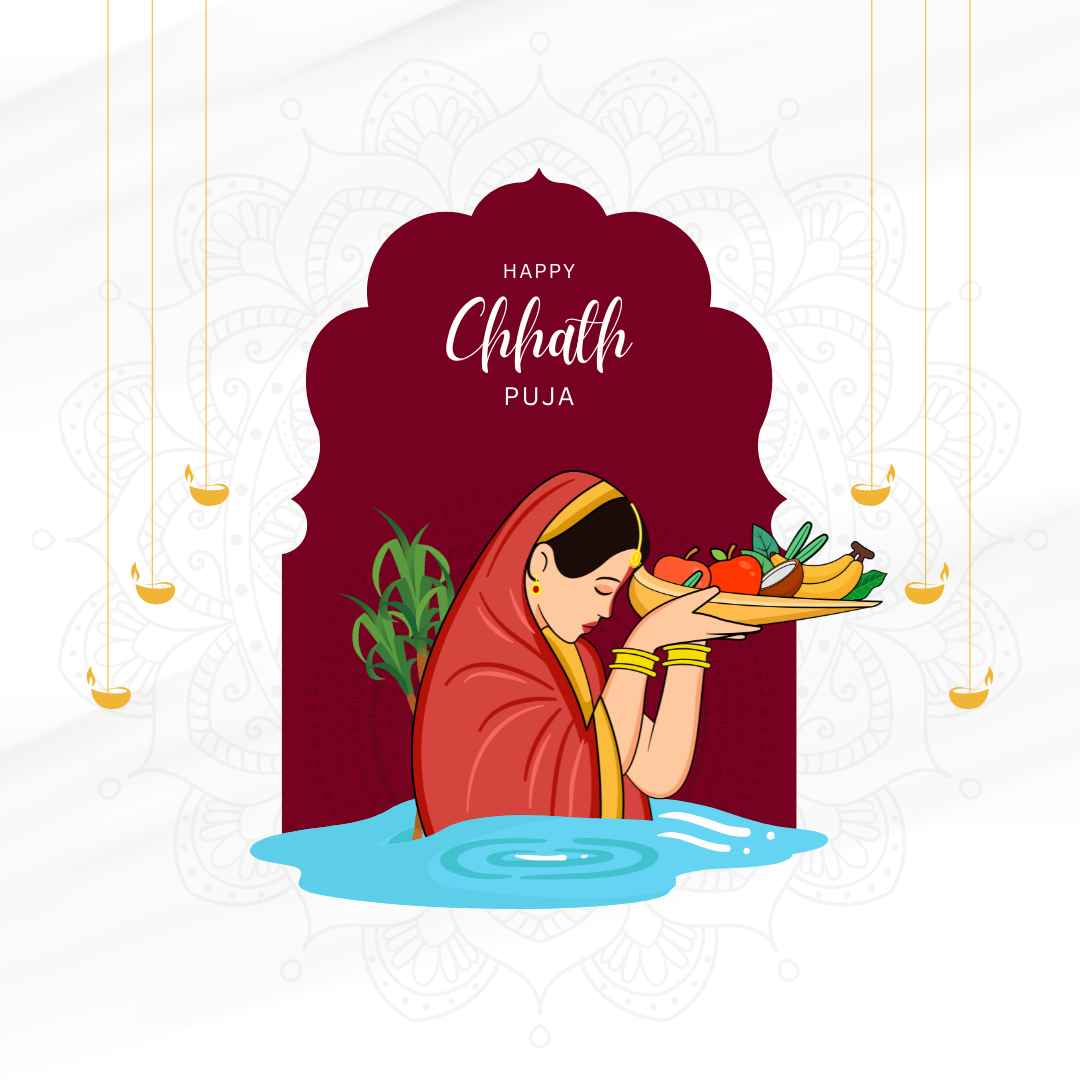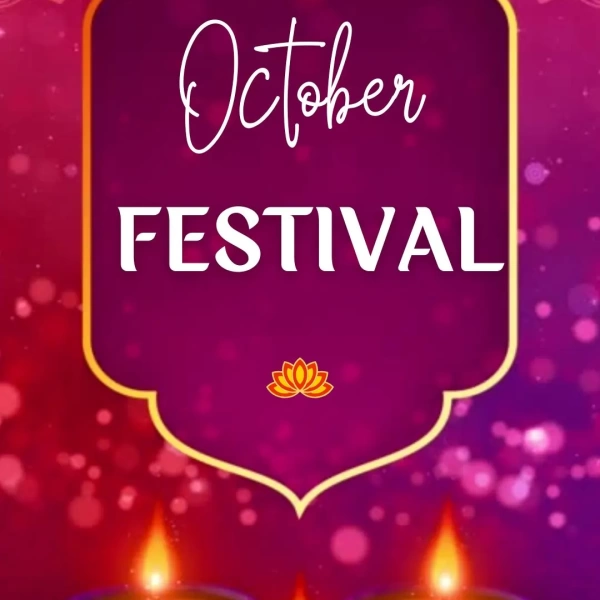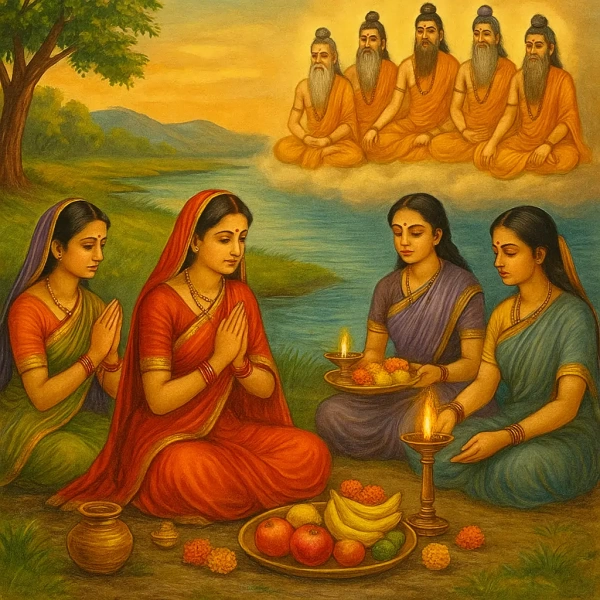Introduction
Chhath Puja stands out as one of India’s most rigorous and eco-conscious festivals. Millions of devotees across Bihar, Jharkhand, Uttar Pradesh, and other regions, including diaspora communities worldwide, observe this ancient Vedic festival to express gratitude to the Sun God for sustaining life and to Chhathi Maiya for blessings, fertility, and prosperity. The festival’s deeply spiritual routines, involving fasting, bathing, and ritual offerings, highlight the sacred connection between humans and nature.
Also read- Festival in October 2025: Complete List of Hindu Festivals
Chhath Puja 2025 Dates & Key Rituals
| Day | Date | Ritual/Event | Sunrise | Sunset |
|---|---|---|---|---|
| Day 1 | Oct 25, 2025 | Nahay Khay | 6:41 AM | 6:06 PM |
| Day 2 | Oct 26, 2025 | Kharna | 6:41 AM | 6:05 PM |
| Day 3 | Oct 27, 2025 | Sandhya Arghya | 6:42 AM | 6:05 PM |
| Day 4 | Oct 28, 2025 | Usha Arghya | 6:42 AM | 6:04 PM |
Day 1: Nahay Khay (नहाय खाय)
Meaning and Rituals
“Nahay Khay” marks the festival’s spiritual beginning. On this day, devotees (called Vrati) bathe in rivers, ponds, or at home, performing a ritual purification. After bathing, Vratis prepare and consume a simple, sattvic meal typically made with lauki (bottle gourd), chana dal, and rice, cooked on a wood or cow-dung stove in bronze or earthen cookware. This meal is the last before the initiation of Chhath’s rigorous fast.
Significance
This act of cleansing purifies body and mind, aligns energy with the solar rhythm, and symbolizes readiness for spiritual discipline. Women play a central role, often preparing food collectively and singing traditional “Chhath geet” (folk songs).
Day 2: Kharna (खरना)
Meaning and Rituals
Kharna is one of the strictest fasting days, with devotees abstaining from water and food from sunrise to sunset. After sundown, Vratis break their fast with a prasad of kheer (jaggery-based rice pudding), chapatis, and bananas offered to Chhathi Maiya. This marks the start of a 36-hour nirjala vrat (waterless fast), maintained until the final sunrise offering.
Significance
The discipline of Kharna symbolically empties and detoxifies the body, creating space for spiritual energy and divine blessings. The evening meal is both a sacred offering and a culinary celebration, shared with family and neighbors.
Day 3: Sandhya Arghya (संध्या अर्घ्य)
Meaning and Rituals
At sunset, devotees gather at water bodies, dressed in traditional attire. Carrying a soop (bamboo basket) filled with offerings—thekua (wheat cookies), sugarcane sticks, turmeric root, coconut, diyas, and seasonal fruits—they stand waist-deep in water and offer “arghya” (water and prasad) to the setting sun. The rituals are accompanied by folk songs, prayers, and devotional hymns.
Significance
Sandhya Arghya expresses gratitude for the sun’s light and energy. The act of standing in water represents harmony with nature. This visually stunning ceremony is a highlight of Chhath Puja, drawing communities together in reverence.
Day 4: Usha Arghya (उषा अर्घ्य)
Meaning and Rituals
The final day begins before sunrise, as devotees return to riverbanks to offer arghya to the rising sun, seeking blessings for health, prosperity, and protection for their children. After the offering, the intense fast is broken by consuming prasad, which is shared joyfully with family, friends, and neighbors.
Significance
Usha Arghya signifies renewal, hope, and the divine promise of abundance. The conclusion of the four-day festival is marked by peace, gratitude, and healing, completing the spiritual and physical detoxification cycle that Chhath Puja represents.
Chhath Puja 2025: Foods and Offerings
- Prasad includes: Thekua, kheer (made with rice, milk, and jaggery), rice laddoos, fruits (especially bananas and sugarcane), and coconut.
- All food is prepared without onion, garlic, or commercial salt, using natural spring or river water when possible.
Also read – Tulsi Vivah 2025: Date, Puja Vidhi & Marriage Significance
Historical and Mythological Roots
Chhath Puja traces its origins to Vedic times, celebrated to honor cosmic balance and invoke blessings for children and families. Myths connect the festival with Draupadi and the Pandavas, who performed rituals to regain power, and with King Priyavrat and Queen Malini, blessed by Chhathi Maiya with a son after years of prayer.
Chhathi Maiya is often identified with Usha, the first rays of the sun, believed to protect children and ensure family well-being.
Environmental and Social Aspects
Chhath Puja’s riverside rituals highlight environmental responsibility, with devotees cleaning ghats, using eco-friendly offerings, and avoiding plastic. The festival also fosters social harmony, with people from all backgrounds participating, sharing prasad, and singing together.
Chhath Puja 2025: Statewise Celebrations
- Bihar & Jharkhand: Grand riverbank ceremonies, folk performances, communal prayers, the epicenter of Chhath Puja.
- Uttar Pradesh: Both urban and rural celebrations, increasingly visible in cities like Lucknow and Varanasi.
- Nepal: Chhath Puja observed along the rivers of Kathmandu and Janakpur, demonstrating its cross-border influence.
- Indian Urban Centers: Migrant families create makeshift ghats, maintain community rituals, and ensure vibrant festivities across Delhi, Mumbai, Kolkata, and more.
Timings for Chhath Puja 2025 (Summary Table)
| Ritual | Date | Sunrise | Sunset |
|---|---|---|---|
| Nahay Khay | Oct 25, 2025 | 6:41 AM | 6:06 PM |
| Kharna | Oct 26, 2025 | 6:41 AM | 6:05 PM |
| Sandhya Arghya | Oct 27, 2025 | 6:42 AM | 6:05 PM |
| Usha Arghya | Oct 28, 2025 | 6:42 AM | 6:04 PM |
Bhakti, Songs, and Communal Joy
Chhath Puja’s rich tradition of folk music (“Chhath geet”) sets the festival’s emotional tone, with songs praising Surya Dev and Chhathi Maiya echoing at sunrise and sunset. Prayers focus on gratitude, devotion, and sincere hope for health and happiness.
Modern Adaptations and Innovations in Chhath Puja 2025
Technological Influence on Rituals
- Digital platforms now offer virtual pooja services for devotees unable to join in person, making it easy for families separated by distance to participate remotely in their traditions.
- Social media amplifies global connections, with devotees sharing photos of pooja items, rangoli designs, and even streaming live ceremonies. This fosters a worldwide sense of community, embracing diaspora participation and inclusivity.
Decorations and Eco-Friendly Trends
- Urban homes and community centers opt for innovative rangoli designs, sometimes using rangoli candleholders and tutorials found online for more elaborate patterns.
- With increased environmental consciousness, devotees choose eco-friendly incense sticks, biodegradable pooja items, and organic marigold strings for decoration. LED diyas and battery-operated pooja accessories are now common, adding convenience and modern aesthetic.
Commercialization and Accessibility
- E-commerce platforms provide ready-to-use Chhath Puja kits, including all necessary pooja items and decorations, making the festival more accessible to urban and global communities.
- Festive markets set up dedicated stalls with traditional items, while online retailers cater to devotees unable to access local shops.
Community Engagement in Urban Spaces
- Urban apartments and residential complexes organize collective celebrations, using pools or makeshift ponds as substitutes for riversides. These events bring together professionals and neighbors, supporting a sense of unity.
- Cultural workshops provide education about the significance of Chhath Puja, preserving tradition while adapting to city lifestyles and encouraging younger generations to stay involved.
Unique Regional Practices
- Bihar remains the epicenter, with extensive ritual detail, marigold string collections, and traditional songs. Jharkhand and Uttar Pradesh communities add their own vibrant styles in decoration, communal singing, and sharing pooja items.
- Terai regions of Nepal embed local crafts, rustic rangoli designs, and unique fruit-based offerings, turning the festival into a broader cultural unity event.
Virtual Celebrations & Global Impact
- Families worldwide connect digitally for prayers, sharing in rituals and distributing prasad even across continents. This ensures that even the new generation abroad maintains deep links to ancestral culture and customs.
- Urban celebrations have adapted with local water features and eco-friendly practices, showing the festival’s ability to evolve while remaining true to its spiritual roots.
Social Significance and Charity
- Chhath Puja is increasingly associated with community service and environmental stewardship. Some groups organize river or lake clean-up drives before the festival, ensuring the holy sites remain pristine.
- Distribution of prasad reaches not just families but the needy, and cultural organizations host inclusive gatherings inviting all backgrounds to participate, celebrating unity and harmony.
Harmony of Tradition and Modernity
Chhath Puja 2025 stands as a living example of cultural resilience and adaptability. Whether through virtual gatherings, eco-friendly innovations, or urban community celebrations, the festival continues to unify families, safeguard traditions, and inspire collective gratitude towards nature. Its evolution shows that even the oldest rituals can thrive in the modern world, enriching both local and global communities.
Conclusion
Chhath Puja 2025 beautifully blends ancient rituals, family devotion, environmental consciousness, and powerful community celebration. Through four inspiring days of fasting, cleansing, singing, and praying, millions join together to honor the sun, express gratitude for existence, and seek the blessings of Chhathi Maiya for a prosperous future. Observing each ritual in its correct timing amplifies the festival’s impact and upholds the tradition’s timeless values.
Also read – Bhai Dooj 2025: Date, Tilak Vidhi & Story


